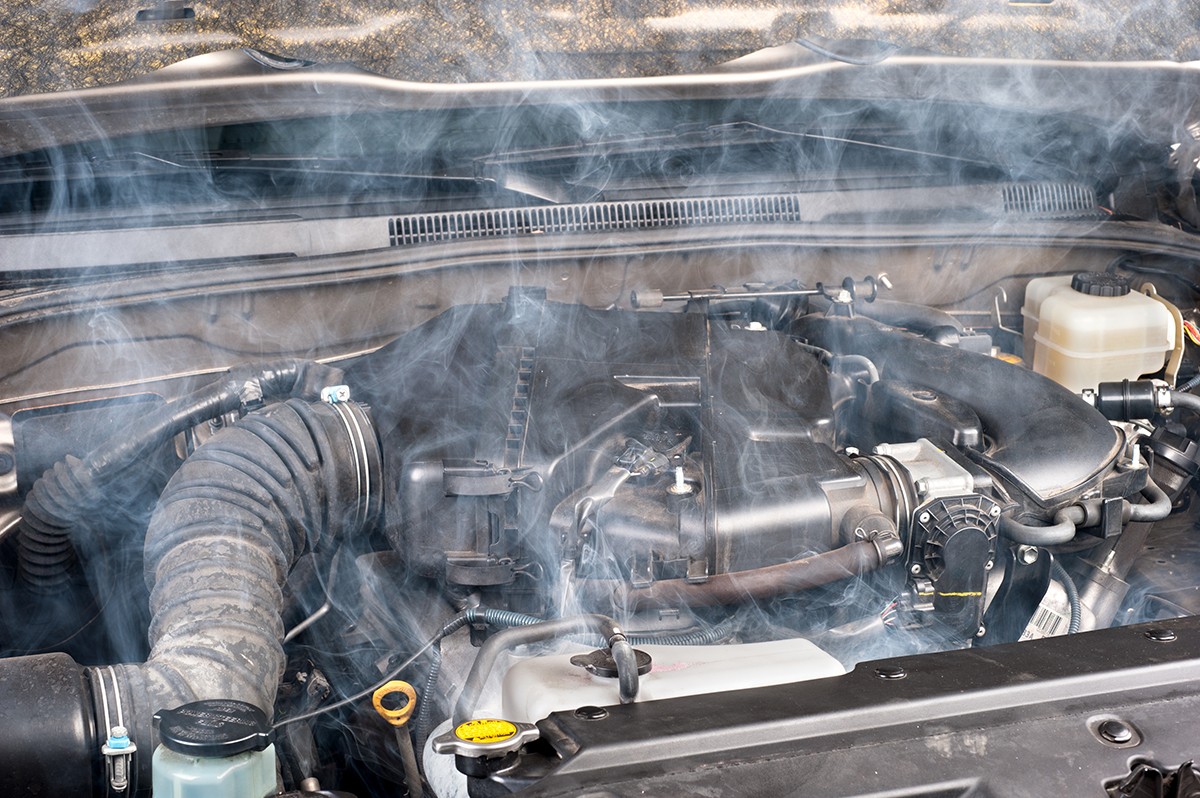Your car’s thermostat, while small, is a vital component in your engine’s cooling system. It ensures your engine runs at the optimal temperature, preventing overheating and ensuring efficient operation. A malfunctioning thermostat can lead to a cascade of issues, from reduced fuel economy to serious engine damage. Recognizing the signs of a bad thermostat is crucial for maintaining your vehicle’s health and avoiding costly repairs. This article will guide you through the telltale signs of a failing thermostat and what steps you can take.
 Smokey car engine indicating overheating, a potential symptom of a bad thermostat.
Smokey car engine indicating overheating, a potential symptom of a bad thermostat.
Recognizing the Symptoms of a Failing Thermostat
When your car’s thermostat starts to fail, it often presents noticeable symptoms. Being aware of these signs can help you address the problem early, preventing more significant engine issues. Here are the key indicators that your thermostat might be going bad:
Sign 1: Erratic Temperature Gauge Readings
One of the most common and easily observable signs of a bad thermostat is inconsistent readings on your car’s temperature gauge. You might notice the gauge fluctuating rapidly, swinging from the normal operating range to hotter than usual and back again in a short period. This erratic behavior indicates the thermostat is struggling to regulate coolant flow properly, leading to unstable engine temperatures.
Sign 2: Engine Overheating
Perhaps the most concerning symptom is engine overheating. If your thermostat is stuck closed, it restricts the flow of coolant to the radiator. Without proper coolant circulation, the engine temperature rises dramatically, leading to overheating. If you see your temperature gauge consistently in the red zone or notice steam coming from under the hood, pull over immediately and let your engine cool down. Overheating can cause severe engine damage, including warped cylinder heads and cracked engine blocks.
Sign 3: Poor Fuel Efficiency
A faulty thermostat can negatively impact your car’s fuel economy. When the thermostat malfunctions and causes the engine to run cooler than its optimal temperature, the engine control unit (ECU) may interpret this as the engine still being in a “warm-up” phase. In this state, the engine often runs richer, meaning it injects more fuel into the combustion chamber. This over-fueling reduces fuel efficiency, causing you to use more gas than usual. If you notice a sudden and unexplained drop in your miles per gallon, a bad thermostat could be a contributing factor.
Sign 4: Heater Malfunction
Your car’s heating system relies on hot coolant circulating through the heater core. If the thermostat is stuck closed or malfunctioning, it can disrupt the flow of hot coolant to the heater core. This can result in weak or no heat coming from your car’s vents, especially during cold weather. If your heater is blowing cold air or taking an unusually long time to warm up, a faulty thermostat could be the culprit.
Sign 5: Coolant Leaks or Low Coolant Levels
While not always directly caused by a thermostat, issues with coolant flow due to a bad thermostat can sometimes lead to coolant leaks or contribute to low coolant levels. A thermostat stuck closed can cause pressure to build up in the cooling system, potentially forcing coolant to escape through the radiator cap, hoses, or other weak points. If you find yourself frequently needing to top off your coolant, it’s a sign that there’s a problem in the cooling system, and the thermostat should be inspected.
Addressing a Bad Engine Thermostat: Steps to Take
Once you suspect a bad thermostat, it’s important to take action to diagnose and resolve the issue. Here’s a breakdown of how to fix a bad engine thermostat:
Step 1: Perform a Diagnostic Check
Before jumping to conclusions and replacing parts, it’s crucial to accurately diagnose the problem. A professional mechanic can perform a comprehensive diagnostic check of your cooling system. This often involves using a scan tool to check for any error codes related to the cooling system and thermostat. A diagnostic check helps confirm whether the thermostat is indeed the issue and rules out other potential problems.
Step 2: Thermostat Replacement
If the diagnostic check confirms a faulty thermostat, replacement is the most common solution. Thermostat replacement is a relatively straightforward repair, but it’s essential to follow the correct procedure for your specific vehicle. The thermostat is typically located inside a housing where the upper radiator hose connects to the engine block.
Here’s a simplified overview of the replacement process:
- Allow the engine to cool down completely.
- Drain some coolant from the radiator to lower the coolant level below the thermostat housing.
- Locate and carefully remove the thermostat housing.
- Remove the old thermostat and note its orientation for proper installation of the new one.
- Install the new thermostat, ensuring it’s the correct type for your vehicle and properly oriented.
- Clean the thermostat housing surfaces and install a new gasket or O-ring.
- Reattach the thermostat housing and tighten the bolts to the manufacturer’s specified torque.
- Refill the cooling system with the correct type and mixture of coolant.
- Bleed the cooling system to remove any air pockets.
- Check for leaks and monitor the temperature gauge after starting the engine to ensure the issue is resolved.
If you are not comfortable performing this repair yourself, it’s best to take your vehicle to a qualified mechanic.
Step 3: Coolant System Flush (Recommended)
When replacing the thermostat, it’s highly recommended to perform a coolant system flush. Over time, coolant can become contaminated with rust, scale, and debris. A coolant flush removes this buildup, ensuring the cooling system operates efficiently and prevents future issues. A flush involves draining the old coolant, using a coolant flush product to clean the system, and then refilling with fresh coolant.
Step 4: Regular Cooling System Maintenance
Preventing future thermostat problems and maintaining overall cooling system health involves regular maintenance. Here are some key maintenance steps:
- Regularly check coolant levels: Ensure your coolant is at the correct level and top off as needed.
- Inspect hoses and belts: Check for signs of wear, cracks, or leaks in coolant hoses and drive belts.
- Coolant flushes: Follow your vehicle manufacturer’s recommended intervals for coolant flushes.
- Monitor temperature gauge: Pay attention to your temperature gauge readings and address any unusual fluctuations promptly.
By being vigilant about the signs of a bad thermostat and taking proactive steps for maintenance, you can ensure your car’s engine stays cool and runs reliably for years to come. Addressing thermostat issues promptly can save you from more extensive and expensive engine repairs down the road.
